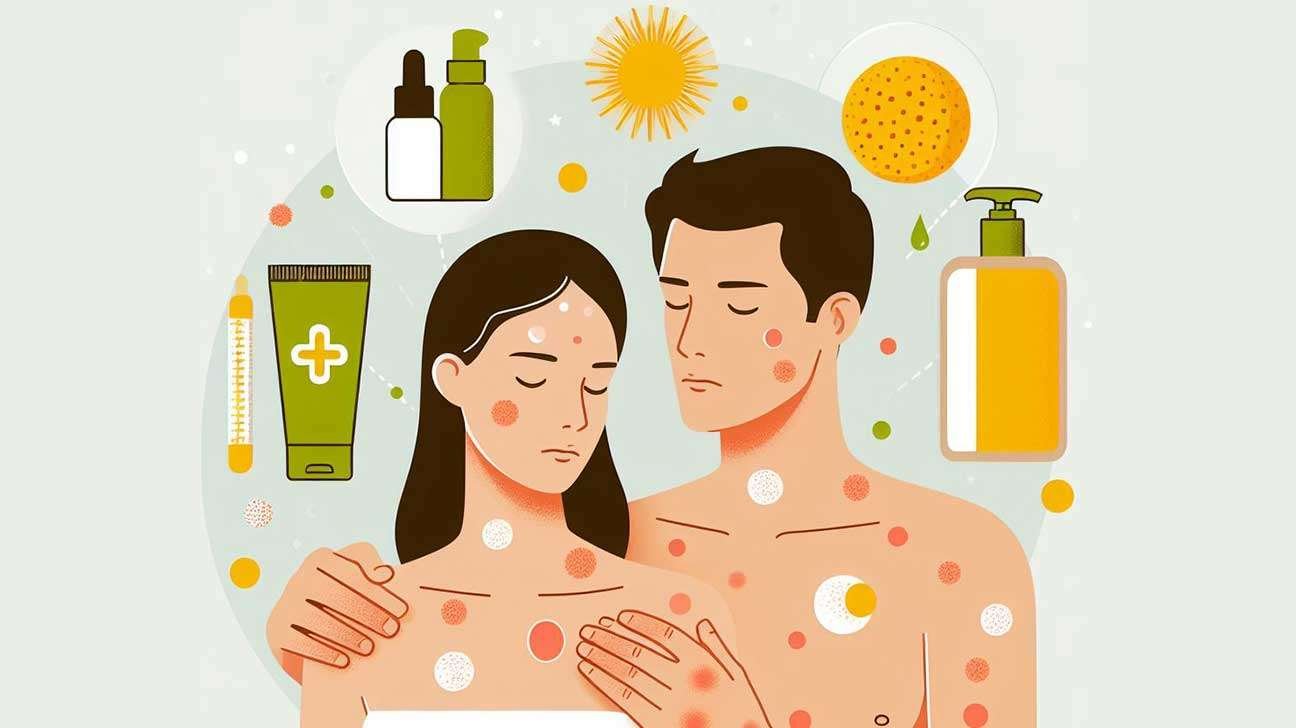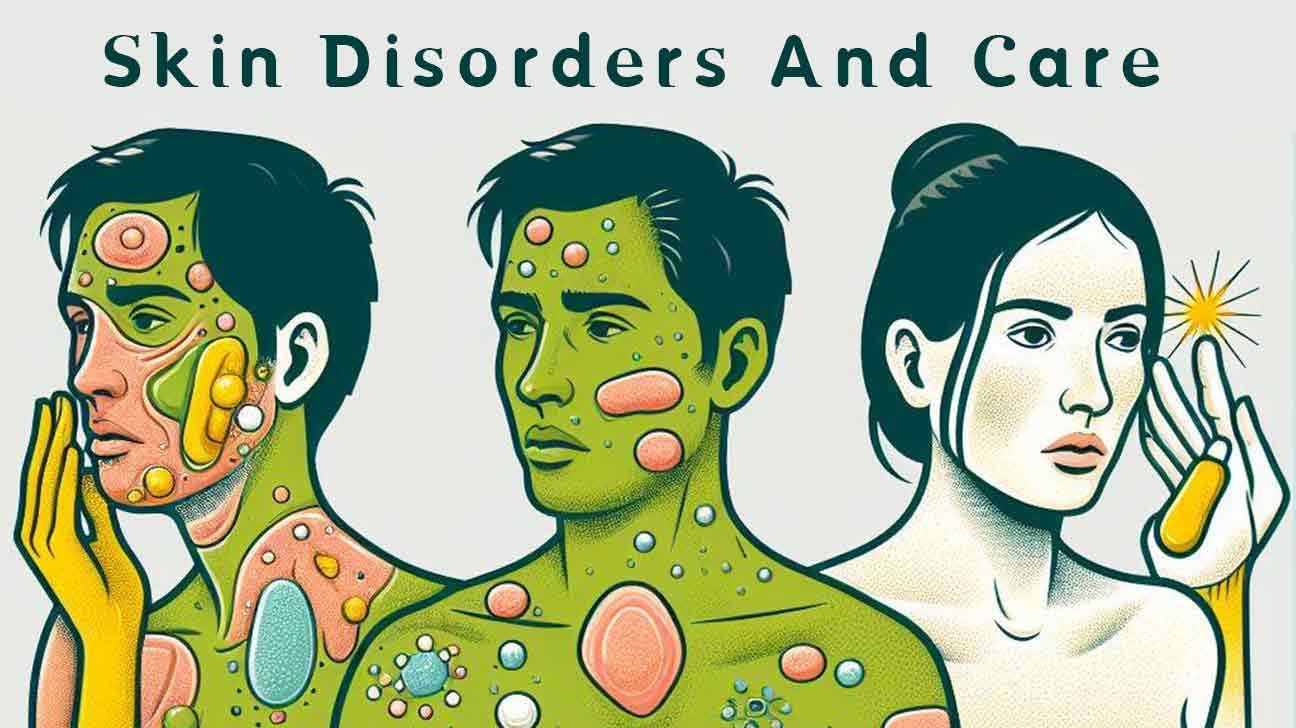
Details Information of Skin Disorders And Care
Skin disorders and care involve effectively managing various skin conditions through lifestyle changes, proper hygiene, and specific treatments suited for each disorder. Taking care of skin diseases includes avoiding certain foods, managing stress, practicing good hygiene, and avoiding excessive alcohol use and smoking.
The most common skin disorders that often present in primary care settings include atopic dermatitis, acne vulgaris, cellulitis/abscess, verruca vulgaris, and benign skin lesions. Treatment for skin problems can involve antihistamines, medicated creams and ointments, and antibiotics. Overall, understanding the symptoms, causes, and treatments for different skin disorders is crucial for maintaining healthy and vibrant skin.
Common Skin Disorders
Skin disorders, such as acne, alopecia areata, and atopic dermatitis, can cause rashes, inflammation, and itchiness. Lifestyle changes, including diet and stress management, along with proper skin care, can help reduce symptoms. Treatment methods may include antihistamines, medicated creams, and antibiotics.
Common Skin Disorders Skin disorders are prevalent and can affect individuals of all ages. Understanding the common skin conditions can help you take better care of your skin. Some of the most common skin disorders include Acne, Eczema, and Psoriasis.
Acne
Acne is a common skin condition that occurs when hair follicles become clogged with oil and dead skin cells, leading to pimples, blackheads, and whiteheads. It is often associated with hormonal changes and can affect people of all ages.
Eczema
Eczema, also known as atopic dermatitis, is a chronic skin condition characterized by inflamed, itchy, and red patches on the skin. It can be triggered by various factors such as allergens, stress, and environmental irritants.
Psoriasis
Psoriasis is a chronic autoimmune condition that speeds up the growth cycle of skin cells, leading to thick, red, and scaly patches on the skin. It can affect any part of the body and may cause discomfort and self-consciousness in individuals. Proper care and management of these common skin disorders are crucial for maintaining healthy skin. Consult with a dermatologist for an accurate diagnosis and personalized treatment plan to address these conditions effectively.
Causes Of Skin disorders
Skin disorders are conditions that affect the skin, causing various symptoms such as rashes, inflammation, itchiness, or other changes. These disorders can be caused by a variety of factors, including hormonal imbalance, genetics, and environmental factors.
Hormonal Imbalance
A hormonal imbalance can play a significant role in the development of skin disorders. Fluctuations in hormones, such as during puberty, pregnancy, or menopause, can lead to an increase in oil production, which can clog the pores and result in conditions like acne.
Genetics
Genetics also plays a crucial role in the development of skin disorders. Certain conditions, such as eczema, psoriasis, and vitiligo, have been found to have a genetic component. If a close family member has one of these conditions, the chances of developing them may be higher.
Environmental Factors
Environmental factors can significantly impact the health of our skin. Exposure to pollutants, chemicals, and ultraviolet (UV) radiation from the sun can damage the skin, leading to conditions like skin cancer, sunburn, or premature aging.
Prevention And Daily Skin Care
Proper skin care is crucial in preventing and managing skin disorders. By following a daily skin care routine that includes proper cleansing, moisturization, and sun protection, you can maintain healthy and radiant skin. Let’s explore each aspect in detail:
Proper Cleansing
Proper cleansing is the foundation of a good skin care routine. It helps remove dirt, oil, and impurities, preventing clogged pores and breakouts. To cleanse your skin effectively:
- Use a mild, fragrance-free cleanser suited for your skin type.
- Gently massage the cleanser onto your face using circular motions, avoiding excessive scrubbing.
- Rinse thoroughly with lukewarm water to remove all traces of cleanser.
- Pat your skin dry with a soft towel, avoiding rubbing.
Moisturization
Moisturizing your skin is essential to maintain its hydration and prevent dryness, flakiness, and irritation. Here’s how you can moisturize effectively:
- Choose a moisturizer that suits your skin type, whether it’s dry, oily, or combination.
- Apply the moisturizer to your face and neck in gentle upward motions.
- Massage it into your skin until it is fully absorbed.
- Don’t forget to moisturize other areas of your body that may be prone to dryness, such as elbows and knees.
Sun Protection
Protecting your skin from the harmful effects of the sun is essential in preventing premature aging, sunburns, and skin cancer. Follow these steps for proper sun protection:
- Apply a broad-spectrum sunscreen with an SPF of 30 or higher, even on cloudy days.
- Generously apply the sunscreen to all exposed areas of your body, including your face, neck, ears, and hands.
- Reapply every two hours, or more frequently if you are sweating or swimming.
- Wear protective clothing, such as wide-brimmed hats and long-sleeved shirts, when spending extended periods in the sun.
By incorporating these preventive measures and daily skin care practices into your routine, you can keep your skin healthy, glowing, and free from common skin disorders. Remember to consult a dermatologist for personalized advice and treatment if you have specific concerns or conditions.
Diet And Lifestyle Impacts of Skin disorders and care
Diet and lifestyle have a significant impact on skin health, with nutrition, stress levels, and lifestyle choices playing a crucial role in the development and management of various skin disorders. Understanding the effects of nutrition, influence of stress, and impact of smoking and drinking can help individuals make informed decisions to maintain healthy skin.
Effects Of Nutrition
Nutrition plays a vital role in skin health, as certain nutrients can promote skin repair and regeneration. Consuming a balanced diet rich in vitamins, minerals, and antioxidants can help maintain healthy skin and prevent common skin disorders.
Influence Of Stress
Stress can negatively impact skin health by increasing inflammation and exacerbating skin conditions. Managing stress through relaxation techniques, exercise, and mindfulness practices can help improve skin condition and overall well-being.
Impact Of Smoking And Drinking
Smoking and excessive drinking can have detrimental effects on the skin, leading to premature aging, wrinkles, and skin damage. Avoiding smoking and moderating alcohol intake can help preserve skin health and reduce the risk of developing skin disorders.
Treatment Options for Skin disorders and care

Skin disorders can cause discomfort and affect one’s confidence. Fortunately, various treatment options are available to address these conditions, ranging from topical and oral medications to non-invasive procedures and surgical interventions. It’s important to consider the specific needs of each individual when determining the most suitable treatment approach.
Topical Medications
Topical medications are commonly used to treat skin disorders, as they can be directly applied to the affected area. These medications may come in the form of creams, ointments, gels, or lotions. They work by targeting the specific symptoms of the skin disorder, providing relief from itching, redness, and inflammation. Common topical medications include corticosteroids, retinoids, and antimicrobial creams.
Oral Medications
Oral medications are prescribed in cases where the skin disorder requires treatment beyond topical applications. These medications are ingested and work systematically to address the underlying causes of the skin condition. They can include antibiotics for bacterial infections, antihistamines for allergic reactions, and immunosuppressants for autoimmune disorders. Oral medications may be used for managing chronic skin conditions such as psoriasis, eczema, or severe acne.
Non-invasive Procedures
Non-invasive procedures offer alternative solutions for individuals with skin disorders. These treatments are typically performed by dermatologists and can include light therapy, laser therapy, and chemical peels. They are designed to target specific areas of the skin to improve texture, reduce pigmentation, and stimulate collagen production. Non-invasive procedures provide effective results with minimal downtime, making them a popular choice for individuals seeking aesthetic improvements or relief from certain skin conditions.
Surgical Interventions
In cases where skin disorders are severe or unresponsive to other treatment options, surgical interventions may be necessary. Procedures such as skin grafting, excision of lesions, and cosmetic surgery can be performed to address the symptoms and underlying causes of the skin disorder. These surgical interventions require careful consideration and may involve longer recovery periods, but they can provide significant improvements in certain skin conditions that have not responded to traditional treatments.
Natural Remedies And Therapies
Natural remedies and therapies are an effective way to address various skin disorders and care needs. From managing symptoms to promoting skin health, these alternatives offer gentle yet powerful solutions. Incorporating natural remedies and therapies into your skincare routine can help provide relief and support skin wellness.
Aloe Vera:
Benefits: Soothes and moisturizes the skin, reduces inflammation.
Use: Apply fresh aloe vera gel directly to affected areas.
Coconut Oil:
Benefits: Acts as a natural moisturizer, has anti-inflammatory and antimicrobial properties.
Use: Apply virgin coconut oil to dry or irritated skin.
Tea Tree Oil:
Benefits: Has antibacterial and antifungal properties.
Use: Dilute tea tree oil with a carrier oil and apply to acne-prone areas.
Oatmeal Baths:
Benefits: Relieves itching and inflammation.
Use: Add colloidal oatmeal to bathwater or make a paste and apply it to the skin.
Honey:
Benefits: Has antimicrobial and anti-inflammatory properties.
Use: Apply raw honey to wounds, burns, or areas affected by skin conditions.
Turmeric:
Benefits: Contains anti-inflammatory and antioxidant compounds.
Use: Make a paste with turmeric and water, apply to affected areas.
Probiotics:
Benefits: Support gut health, which can influence skin conditions.
Use: Consume probiotic-rich foods like yogurt or take supplements.
Green Tea:
Benefits: Contains antioxidants that can help reduce inflammation.
Use: Apply cooled green tea bags or a green tea extract to the skin.
Essential Oils:
Benefits: Lavender, chamomile, and calendula oils can have soothing effects.
Use: Dilute and apply topically, or add a few drops to bathwater.
Healthy Diet:
Benefits: Nutrient-rich foods support overall skin health.
Include: Fruits, vegetables, omega-3 fatty acids, and foods high in antioxidants.
Hydration:
Benefits: Keeps the skin moisturized and supports overall health.
Tips: Drink plenty of water and use a humidifier in dry environments.
Stress Management:
Benefits: Reduces stress-related skin issues.
Activities: Practice meditation, yoga, or deep breathing exercises.

Tips For Healthy Skin
Having healthy skin is crucial for your overall well-being. By following these tips, you can maintain a glowing complexion and prevent common skin disorders. Let’s explore the key aspects of skincare to keep your skin radiant and healthy.
Hydration
- Drink plenty of water throughout the day to keep your skin hydrated.
- Use moisturizers daily to lock in moisture and prevent dryness.
- Avoid excessive caffeine and alcohol consumption as they can dehydrate your skin.
Balanced Diet
- Eat a variety of fruits and vegetables rich in vitamins and antioxidants to nourish your skin.
- Include omega-3 fatty acids found in fish, nuts, and seeds for healthy skin cells.
- Limit processed foods and sugars to maintain skin clarity and elasticity.
Exercise
- Engage in regular physical activity to improve blood circulation, delivering essential nutrients to your skin.
- Sweating during exercise helps cleanse your pores and promote a clear complexion.
- Choose workouts that reduce stress levels, which can contribute to skin issues.
Stress Management
- Practice meditation or mindfulness to alleviate stress and prevent inflammatory skin conditions.
- Find relaxation techniques that work for you, such as yoga or deep breathing exercises.
- Seek support from friends and family to maintain emotional well-being and healthy skin.
Good Sleep
- Establish a regular sleep routine to allow your skin to repair and regenerate overnight.
- Invest in quality bedding to prevent skin irritation and promote a restful sleep.
- Avoid screen time before bed to improve sleep quality and skin health.
Effects Of Ageing On Skin
As we age, our skin undergoes several changes that can affect its appearance and health. Understanding these effects is crucial for proper skincare and maintaining a youthful complexion. In this article, we will explore three common signs of ageing skin: wrinkles and fine lines, uneven skin tone, and loss of elasticity.
Wrinkles And Fine Lines
One of the most visible signs of ageing on the skin is the development of wrinkles and fine lines. Over time, the production of collagen and elastin, which are essential proteins for maintaining skin elasticity and smoothness, decreases. The skin becomes thinner and less able to retain moisture, resulting in the formation of wrinkles and fine lines.
There are several factors that contribute to the development of wrinkles and fine lines, including genetics, sun exposure, smoking, and repetitive facial expressions. Skin areas that are most prone to wrinkles include the face, neck, and hands.
To minimize the appearance of wrinkles and fine lines, it is essential to adopt a comprehensive skincare routine. This includes cleansing, exfoliating, moisturizing, and protecting the skin from sun damage. Additionally, incorporating skin products containing retinoids, antioxidants, and hyaluronic acid can help stimulate collagen production and improve the overall texture of the skin.
Uneven Skin Tone
An uneven skin tone is another common effect of ageing. As we age, the skin’s natural ability to shed dead skin cells slows down, leading to a build-up of pigmented cells and a dull complexion. Sun damage and hormonal changes can also contribute to the development of age spots and hyperpigmentation.
To address uneven skin tone, it is important to incorporate exfoliation into your skincare routine. Regular exfoliation helps to remove dead skin cells and promote a more even skin tone. Additionally, using products with brightening ingredients such as vitamin C, niacinamide, and kojic acid can fade pigmentation and improve overall skin brightness.
Protecting the skin from harmful UV rays by wearing sunscreen with a high SPF is also crucial in preventing further damage and maintaining an even skin tone.
Loss Of Elasticity
The loss of elasticity is another significant effect of ageing on the skin. As collagen and elastin fibers break down, the skin becomes less firm and more prone to sagging and drooping. Factors such as sun exposure, smoking, and poor skincare can accelerate this process.
To combat the loss of elasticity, incorporating skincare products that promote collagen production, such as peptides and vitamin A derivatives (retinoids), can be beneficial. Regular facial massages and exercises can also help improve blood circulation and tone the facial muscles, leading to firmer skin.
Furthermore, practicing a healthy lifestyle, including a balanced diet, regular exercise, and avoiding smoking and excessive alcohol consumption, can contribute to maintaining healthy skin elasticity.
By understanding the effects of ageing on the skin and implementing a targeted skincare routine, you can effectively address and minimize the appearance of wrinkles and fine lines, uneven skin tone, and loss of elasticity. Remember to prioritize sunscreen usage and consult with a skincare professional for personalized recommendations.
Skin Care Routine For Different Skin Types
Caring for your skin is essential to maintain its health and appearance. However, not all skin types are the same, and each requires a tailored skin care routine. Understanding your skin type is the first step in creating an effective and personalized routine. In this article, we will discuss the skin care routines for different skin types and provide some tips and recommendations.
Normal Skin
Normal skin is considered well-balanced, with a good level of moisture and few imperfections. People with normal skin are lucky as they have fewer skin care challenges compared to other skin types. However, this does not mean that they should neglect their skin. Here are some tips for a skin care routine for normal skin:
- Cleanse: Use a gentle cleanser to remove dirt, oil, and impurities.
- Tone: Apply a toner to balance the skin’s pH levels and tighten the pores.
- Moisturize: Apply a lightweight moisturizer to keep the skin hydrated.
- Protect: Use a broad-spectrum sunscreen with at least SPF 30 to protect the skin from harmful UV rays.
Dry Skin
Dry skin lacks moisture and tends to feel tight, rough, and sometimes itchy. It requires extra care and hydration to maintain a healthy glow. Here are some tips for a skin care routine for dry skin:
- Cleanse: Use a mild, hydrating cleanser that does not strip away natural oils.
- Exfoliate: Gently exfoliate once or twice a week to remove dead skin cells and promote cell turnover.
- Moisturize: Apply a rich, emollient moisturizer to replenish moisture and nourish the skin.
- Protect: Use a moisturizer with SPF during the day and consider using a humidifier to add moisture to the air.
Oily Skin
Oily skin tends to produce excess sebum and can feel greasy, shiny, and prone to acne and breakouts. A proper skin care routine can help control oil production and maintain a balanced complexion. Here are some tips for a skin care routine for oily skin:
- Cleanse: Use a gentle cleanser specifically formulated for oily skin to remove excess oil and impurities.
- Tone: Apply an alcohol-free toner to balance the skin’s pH levels and minimize the appearance of pores.
- Moisturize: Opt for a lightweight, oil-free moisturizer to hydrate the skin without clogging the pores.
- Protect: Use a non-comedogenic sunscreen with at least SPF 30 to protect the skin without causing breakouts.
Combination Skin
Combination skin is a combination of oily and dry skin, with different areas of the face exhibiting different characteristics. The key is to balance and target the specific needs of each area. Here are some tips for a skin care routine for combination skin:
- Cleanse: Use a gentle cleanser to remove dirt and oil without drying out the skin.
- Treat: Use a targeted treatment for oily areas, such as a salicylic acid-based product, and a hydrating treatment for dry areas.
- Moisturize: Apply a lightweight moisturizer to the entire face, focusing on the dry areas.
- Protect: Use a sunscreen with at least SPF 30 to protect the entire face.
Sensitive Skin
Sensitive skin is easily irritated and can react to certain ingredients or environmental factors. It requires gentle and soothing products to minimize irritation and redness. Here are some tips for a skin care routine for sensitive skin:
- Cleanse: Use a fragrance-free and hypoallergenic cleanser to avoid any potential irritants.
- Moisturize: Choose a moisturizer with calming ingredients, such as aloe vera or chamomile.
- Protect: Use a mineral-based sunscreen with at least SPF 30 to protect the skin without causing irritation.
- Avoid irritants: Avoid using harsh exfoliants, fragrance, and alcohol-based products that can further irritate the skin.
Remember, consistency is key when it comes to skin care. Stick to your routine and make adjustments as needed based on your skin’s needs. If you’re unsure about which products to use, consult with a dermatologist for personalized recommendations. Take care of your skin, and it will thank you with a healthy and radiant complexion!
When To Seek Professional Help
Addressing skin disorders promptly is crucial for healthy skin. Seek professional help if experiencing persistent symptoms or uncertainty about skincare concerns. Early intervention can prevent skin conditions from worsening and promote overall skin health.
Persistent Symptoms
If your skin condition persists despite home remedies or over-the-counter treatments, it’s advisable to consult a dermatologist for expert evaluation.
Severe Discomfort
In case you experience severe discomfort, pain, or itching that interferes with your daily activities, seeking professional help is crucial for effective management.
Suspected Skin Cancer
If you notice any new or changing moles, growths, or lesions on your skin that raise concerns about potential skin cancer, do not hesitate to schedule an appointment with a dermatologist promptly.
Frequently Asked Questions Of Skin Disorders And Care
What Are The Top 10 Skin Diseases?
The top 10 skin diseases are acne, alopecia areata, atopic dermatitis, epidermolysis bullosa, hidradenitis suppurativa, ichthyosis, pachyonychia congenita, pemphigus, psoriasis, and vitiligo. These diseases cause rashes, inflammation, itchiness, and other skin changes. Treatment options include antihistamines, medicated creams, and ointments.
Lifestyle changes such as avoiding certain foods, managing stress, practicing good hygiene, and avoiding excessive alcohol and smoking can also help.
How Do You Take Care Of Skin Disease?
To take care of skin diseases, make lifestyle changes like avoiding certain foods, managing stress, practicing good hygiene, and avoiding excessive alcohol and smoking. Common treatment methods include using antihistamines, medicated creams, and antibiotics.
What Is A Common Skin Disorder In Primary Care?
Common skin disorders in primary care include atopic dermatitis, acne vulgaris, cellulitis/abscess, verruca vulgaris, and benign skin lesions.
Which Treatment Is Best For Skin Problems?
A variety of treatments, such as antihistamines, medicated creams, and antibiotics, can effectively address various skin problems.
What Are The Most Common Skin Disorders?
Some of the most common skin disorders include acne, eczema, psoriasis, rosacea, and dermatitis.
skin discoloration on legs images
Skin Discoloration on Legs: Overview and Visual Descriptions
Skin discoloration on the legs can manifest in various forms, each associated with different underlying causes. While I can’t provide images directly, I can offer detailed descriptions of common types of skin discoloration on legs and suggest reputable sources where you can view illustrative images. Understanding these conditions can help in identifying potential causes and seeking appropriate medical advice.
Common Types of Skin Discoloration on Legs
-
Hyperpigmentation
- Description: Darkened patches or spots on the skin.
- Causes:
- Post-Inflammatory Hyperpigmentation: Dark spots following skin injury or inflammation (e.g., after cuts, burns, or infections).
- Sun Exposure: Increased melanin production due to prolonged sun exposure.
- Hormonal Changes: Conditions like melasma can cause hyperpigmentation.
- Appearance: Evenly or unevenly darkened areas compared to surrounding skin.
-
Hypopigmentation
- Description: Lighter patches of skin compared to surrounding areas.
- Causes:
- Vitiligo: Autoimmune condition causing loss of pigment-producing cells.
- Post-Inflammatory Hypopigmentation: Light spots following skin injury or inflammation.
- Appearance: Clearly defined white or lighter patches on the legs.
-
Livedo Reticularis
- Description: A lace-like, purplish discoloration forming a net-like pattern.
- Causes:
- Vascular Conditions: Poor blood circulation, vasculitis, or other blood vessel disorders.
- Cold Exposure: Temporary response to cold temperatures.
- Appearance: Reticulated (net-like) purplish-blue pattern across the skin.
-
Acanthosis Nigricans
- Description: Dark, thickened, velvety patches of skin.
- Causes:
- Insulin Resistance: Often associated with obesity and type 2 diabetes.
- Hormonal Disorders: Such as polycystic ovary syndrome (PCOS).
- Certain Medications: Can trigger this condition as a side effect.
- Appearance: Darkened, rough patches typically in skin folds but can appear on legs.
-
Varicose Veins
- Description: Enlarged, twisted veins visible beneath the skin surface.
- Causes:
- Venous Insufficiency: Weakened valves in veins leading to blood pooling.
- Genetics: Family history increases risk.
- Lifestyle Factors: Prolonged standing, obesity, and aging.
- Appearance: Bulging, blue or dark purple veins often accompanied by skin changes like pigmentation or eczema.
-
Diabetic Dermopathy
- Description: Light brown, scaly patches on the skin.
- Causes:
- Diabetes: Common skin condition in individuals with diabetes.
- Appearance: Small, round or oval patches, often on the shins.
-
Erythema Nodosum
- Description: Inflammatory condition presenting as tender red nodules.
- Causes:
- Infections: Such as streptococcal infections.
- Inflammatory Diseases: Like sarcoidosis or inflammatory bowel disease.
- Medications: Certain drugs can trigger this reaction.
- Appearance: Raised, red or purple nodules usually on the front of the legs below the knees.
-
Contact Dermatitis
- Description: Red, itchy, and inflamed skin reaction.
- Causes:
- Allergens or Irritants: Such as certain fabrics, soaps, or chemicals.
- Appearance: Redness, swelling, and possibly blisters where the skin has come into contact with the offending substance.
-
Leg Ulcers
- Description: Open sores or wounds on the legs.
- Causes:
- Venous Insufficiency: Leading to poor blood flow and ulcer formation.
- Arterial Disease: Reduced blood supply causing sores that are slow to heal.
- Diabetes: Increased risk of infections and poor healing.
- Appearance: Open wounds that may be accompanied by surrounding skin discoloration and scarring.
Where to View Images
For visual references, consider visiting reputable medical websites that provide detailed images and further explanations:
- DermNet NZ: Comprehensive resource with images of various skin conditions.
- Mayo Clinic: Offers patient-friendly images and detailed condition descriptions.
- WebMD: Provides images and information on a wide range of health conditions.
- American Academy of Dermatology: Features educational materials and images on skin disorders.
When to Seek Medical Advice
If you notice unexplained skin discoloration on your legs, it’s important to consult a healthcare professional, especially if accompanied by other symptoms such as:
- Persistent pain or discomfort
- Swelling or changes in skin texture
- Ulcers or open sores
- Rapid changes in skin appearance
Early diagnosis and treatment can address underlying conditions effectively and prevent potential complications.
Conclusion
Skin discoloration on the legs can result from various factors, ranging from benign conditions like hyperpigmentation to more serious vascular or systemic issues. Understanding the different types and their appearances can aid in recognizing when to seek medical evaluation. For accurate diagnosis and appropriate treatment, consulting with a dermatologist or healthcare provider is recommended.
If you have specific concerns or need more detailed information about a particular condition, feel free to ask!
In caring for your skin, lifestyle changes can help reduce symptoms of skin conditions. Manage stress, practice good hygiene, and heed your healthcare provider’s advice. Remember, many skin disorders are treatable with medications and proper skincare. Stay informed and seek professional guidance for optimal skin health.




